As promised, part two of making a garden apron—with pockets, because that's the
whole point and also the fashion hill I will die on.
 |
My child.
|
First, an interlude with the ginger that rose from the dead, who is doing splendidly, and may even be preparing to send up another shoot. Meanwhile, the ginger I bought from the grocery store, which really shouldn't be capable of growing, is greening up and beginning to shoot out. I guess...I'll plant it...too...? I was kind of hoping to
eat that root, though.
Anyway, the sewing!
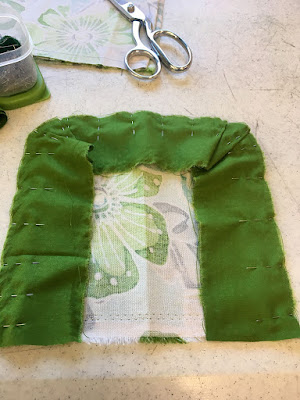 |
| Those miters only took me like ten minutes. |
I saved the cutout from the neckline of the front apron piece to make a small pocket for things like seed packets and my phone, to keep them from being crushed by whatever else I might stow in the larger pocket I was planning. Of course, I also wanted to make it stand out from the main apron—the busy pattern is on purpose, but it does conceal seam lines and detailing, and patch pockets are really meant to be seen. So I tore a nearly-three-inch strip of the gold dot fabric, and pinned it to make a little edge binding.
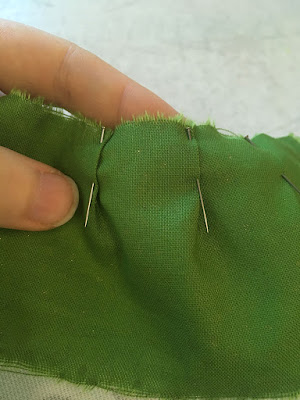 |
| I have no idea what I'm doing. |
Generally binding that has to go around curves is
bias binding. I am lazy, and I was also
secretly hoping to have enough gold dot fabric left over to face the hem of my denim skirt, because that would be adorable and more or less my secret (aside from...all of you, who now know). So I tore straight strips, and made tiny tucks wherever I needed them to keep the binding running more-or-less smoothly around the pocket edges.
 |
| This machine and I don't really get along yet. |
Got lots of practice in following curves, pulling pins without letting pleats collapse, and generally being inept-but-determined.
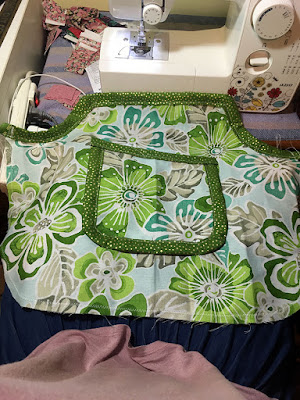 |
| Cute. As. Shit. |
I skipped the bit where I folded and pinned and folded and pinned, trying desperately for a smoother finish to the corners. It wasn't graceful, nor could I take a photo with both hands occupied while swearing steadily. Instead, you get to see the result! A big pocket, with a little pocket (and binding the top edge of the little pocket was
such a treat—all straight lines, nothing fancy at all), and zigzag to stabilize the side/lower edges of the big pocket, because I felt like it. And I'm still hoping for enough gold dot fabric to do a hem facing.
Rather than try to wrestle the big pocket and the apron front through the machine so the attaching seam would be hidden on the inside of the pocket, I folded under the raw edge and ran another zigzag stitched line just inside the fold. It's decorative where it's visible, as well as being one more layer of reinforcement for the raw edge (and whatever I end up stowing in that pocket—tomatoes? sweet potatoes? rocks? Could be anything).
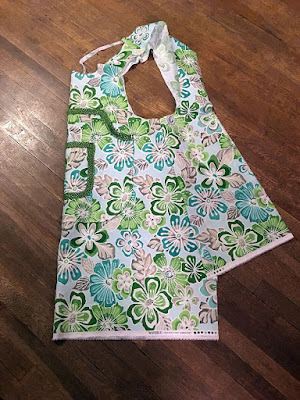 |
| I like that this side seam almost matches so well. |
And then it was time to refine the hem! I laid the apron out as neatly as I could, folded in half so no matter what I did, it would be symmetrical enough for my purposes.
 |
| Much better. |
And chopped off the corners! Since it really was just removing the corners, I didn't end up wasting much fabric this way—no more, I think, than I would have if I'd cut the pieces in their final shapes to begin with.
The little tail of cut fabric at the top of the apron is where I started trimming my monstrous seam allowance down, thinking I'd do the binding for the top edge while the hem was still made of selvedges. I realized, once I had the apron on my lap and tried to straighten it out, that crossing the straps before seaming them turned the whole garment into a Möbius strip (or some related geometric concept). So I abandoned the trimming to correct the hem first, and then went back to trim down seam allowances and pin more binding on.
Lots more. It took me about four hours to pin and stitch the binding on the edge (singular!! that's so weird) of this apron.
But I have just enough fabric left to face the hem of my skirt.
I love it so much. It fits well, and hangs nicely—getting in and out of it will take some getting used to, without straps to undo so much as wriggle out of—and the pockets are
exactly where they ought to be.
I'll need to dig up a pair of buttons at some point, and make little loops or buttonholes in the top corners of the big pocket. The shaped top edge is charming, but it needs some help to stay up, and I don't want to stitch any more of it down. If I did, I'd either have an awkwardly high opening in the center, or two perfectly-placed openings at the sides, without enough room to get anything larger than my hand into the pocket. That's the exact opposite of the plan.
Not too shabby for my third project on the sewing machine. I didn't even wimp out and hand-stitch the binding down.







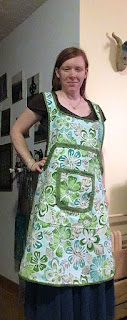


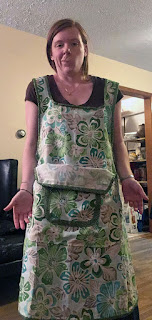
Comments
Post a Comment